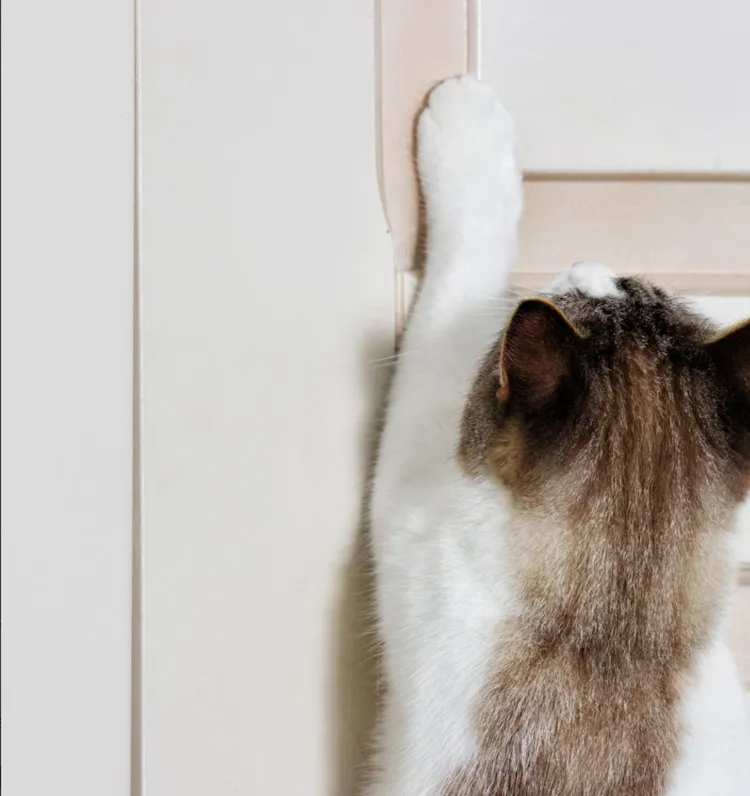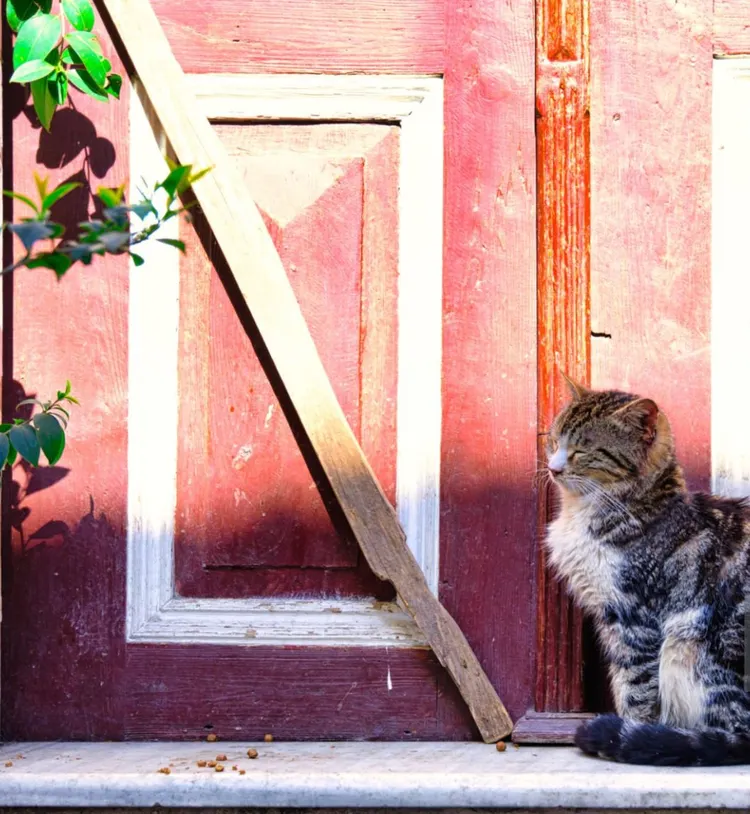If your cat’s door-scratching has you reaching for noise-canceling headphones, don’t worry—you’re not alone. Cats scratching doors is a common problem for many pet owners. While the sound can be annoying and the damage to your door can be frustrating, this behavior is often your cat’s way of communicating something important. Fortunately, there are expert-proven ways to help you (and your door) survive without resorting to harsh methods. Let’s dive into understanding why cats scratch doors and how you can stop it in a way that’s humane, effective, and environmentally friendly.
Why Do Cats Scratch Doors?
Before jumping into the solutions, it’s essential to understand why cats engage in this behavior. Scratching is a natural and necessary part of a cat’s life. It serves several purposes:
- Stretching and Exercise: Scratching helps cats stretch their muscles, particularly those in their legs, shoulders, and paws.
- Marking Territory: Cats have scent glands in their paws, and scratching leaves both a visual and scent mark. It’s a way of saying, “This is mine.”
- Claw Maintenance: Scratching helps remove the dead outer layer of their claws, keeping them sharp and healthy.
- Attention-Seeking or Frustration: If your cat is scratching the door, they might be trying to get your attention or expressing frustration, especially if they feel ignored, bored, or anxious.
Understanding these motives can guide you in selecting the most effective solution for your cat’s specific needs.
The Ultimate Proven Solutions
Now that we know why cats scratch, let’s explore the best ways to stop door-scratching while still respecting your cat’s instincts and needs.
1. Provide Alternative Scratching Options
One of the easiest ways to deter a cat from scratching doors is to provide them with an appealing alternative. Cats naturally gravitate toward rough, vertical surfaces. You can encourage them to scratch elsewhere by offering a sturdy scratching post or board.
- What to Look For: Choose a scratching post or board that’s tall enough for your cat to fully stretch their body. Look for eco-friendly options made from recycled materials like cardboard or sustainably sourced sisal.
- Placement is Key: Place the scratching post near the door where your cat tends to scratch. This helps redirect their behavior to the appropriate spot.
By offering them an appealing alternative, you can meet your cat’s need to scratch without sacrificing your door.
2. Use a Physical Barrier
A simple but effective method is to create a barrier that makes the door less appealing to scratch.
- Sticky Tape or Foil: Cats dislike the texture of sticky tape or foil. Apply a cat-safe, eco-friendly adhesive like double-sided sticky tape to the areas they’re scratching. Aluminum foil can also be effective, as many cats dislike the sound and feel of it.
- Temporary but Effective: This technique won’t harm your cat and is a great short-term solution while you’re training them to use a scratching post instead.
Ensure that the materials you use are non-toxic and safe for both your pet and the environment.
3. Redirect Their Attention
Sometimes, scratching is a sign that your cat is seeking attention or stimulation. To reduce this behavior, it’s important to ensure they’re getting enough mental and physical activity throughout the day.
- Interactive Toys and Puzzles: Engage your cat with interactive toys, food puzzles, or treat-dispensing toys. These activities can help channel their energy and keep them entertained, reducing the likelihood that they’ll scratch doors out of boredom.
- Scheduled Playtime: Dedicate specific times each day for play sessions. Cats, particularly young or active ones, need opportunities to run, jump, and hunt.
By giving your cat more ways to expend their energy, you can make door-scratching less likely.
4. Use Natural Deterrents
If you’re looking for an eco-friendly way to deter your cat from scratching the door, consider using natural scent deterrents.
- Citrus or Rosemary Sprays: Cats generally dislike the smell of citrus or rosemary. You can apply a non-toxic, plant-based deterrent spray near the door to keep them away from the area.
- DIY Options: Make your own deterrent by mixing water with a few drops of citrus essential oil (lemon or orange) or rosemary. Always ensure that any essential oils you use are safe for pets and diluted properly.
This method is safe for your cat and won’t damage the environment, making it a sustainable option.
5. Create a Calm Environment
Cats may scratch doors out of stress or anxiety, especially if there are changes in their environment or daily routine.
- Pheromone Diffusers: Try using a pheromone diffuser like Feliway, which emits calming scents that mimic a cat’s natural pheromones. This can help reduce anxiety and, in turn, door-scratching behavior.
- Natural Calming Products: You can also explore natural calming supplements or sprays that include ingredients like chamomile or valerian root. These products can help soothe your cat and prevent stress-related scratching.
A calm cat is less likely to engage in destructive behaviors, so creating a peaceful environment is key.
6. Train Your Cat Using Positive Reinforcement
Training your cat not to scratch the door is possible through positive reinforcement. Instead of punishing your cat for scratching, reward them when they stop or when they use an appropriate scratching post.
- Treats and Praise: When your cat uses their scratching post, offer them a treat or praise to encourage the behavior. Positive reinforcement helps your cat understand that scratching the post, rather than the door, is rewarded.
- Consistency is Key: Be consistent in your training, rewarding your cat immediately when they exhibit good behavior. Over time, your cat will associate scratching the post with positive outcomes.

Long-Term Training Tips
Training your cat to stop scratching doors requires patience and consistency. It’s essential to remember that cats are creatures of habit, and it may take time for them to unlearn their behavior. Here are a few long-term tips:
- Stay Patient: Don’t expect overnight results. Some cats may take longer to adapt to changes, so be patient and persistent with your training techniques.
- Avoid Punishment: Never punish your cat for scratching. This can lead to increased anxiety and potentially worsen the behavior. Focus on positive reinforcement instead.
- Offer Enrichment: Regularly rotate your cat’s toys and provide new scratching posts or surfaces to keep them interested.
Eco-Friendly Solutions for Scratching Behavior
Being an eco-conscious pet owner means looking for sustainable solutions to care for your cat. Here are some eco-friendly ideas to help curb your cat’s door-scratching:
- Natural Scratching Posts: Opt for scratching posts made from recycled materials like cardboard or sustainably sourced wood and sisal.
- DIY Scratching Posts: Consider making your own scratching posts or boards using upcycled items. For example, old carpet scraps or repurposed wood can create an appealing scratching surface for your cat.
- Non-Toxic Cleaners and Repellents: When cleaning or deterring your cat from certain areas, use non-toxic, biodegradable cleaning products that won’t harm your cat or the environment.
By making eco-friendly choices, you can prevent door-scratching while reducing your environmental footprint.
Why Stopping Door-Scratching is Important
Stopping your cat from scratching doors goes beyond just preserving your home’s aesthetics. Here’s why it’s important:
- Prevent Damage: Scratching can cause unsightly damage to your doors, which can be costly to repair or replace over time.
- Reduce Stress for Both You and Your Cat: Constant scratching can be stressful for both the cat and the owner. Reducing this behavior can lead to a more peaceful, harmonious relationship.
- Promote Healthy Claws: Providing alternative scratching options ensures that your cat can still maintain their claws healthily without damaging your home.
Conclusion
Dealing with a cat that scratches doors can be frustrating, but the solution lies in understanding why your cat scratches and addressing their needs. By providing alternative scratching options, using eco-friendly deterrents, and employing positive reinforcement techniques, you can train your cat to stop this behavior in a humane and effective way. Plus, with a little creativity and sustainability, you can ensure that your approach is kind to the environment.
Remember, consistency is key. Over time, your cat will learn new habits, and both your home and your relationship with your feline friend will benefit.



